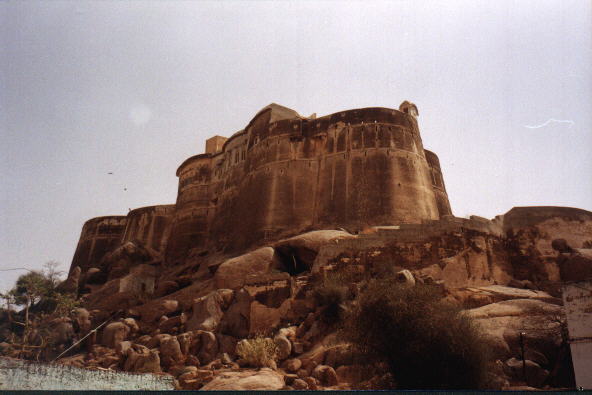History
Rao Raja Laxman Singh of Sikar constructed the Laxmangarh Fort in 1862 AD, and around it he established the present Laxmangarh town was founded in 1864.
Rao Raja Laxman Singh of Sikar Thikana planned it nearly 200 years ago under the Shekhawati region of erstwhile Rajputana. The reigning kingdom of jaipur had many thikanas and Shekhwati was one of them. The jagirdars of these thikanas were called Rao Rajas and Laxman Singh happened to be the Rao Raja of Sikar and founder of Laxmangarh.
Most recently, Laxmangarh has been of public curiosity due to its place in modern literature. The fictional character Balram Halwai from the bestselling novel The White Tiger by Aravind Adiga came from a village by the same name, but it isn't be the same village, because the book is actually set in the Gaya District in the vicinity of Bodh Gaya in the state of Bihar.
Geography
Laxmangarh is located at
27.8225°N 75.025278°E.[2] It has an average elevation of 222 metres (728 ft). The Laxmangarh Fort is the best monument of the town.
The nearing area of the Laxmangarh town are also very rich in heritage. The PEER Baba ki Samadi located in the revenue village of Alkhpura Bogan near Hapas is also a 300-year-old monument. The monument is a place of worship for both the Hindus and Muslims of the area. The great fair is organised every year on the sixth of Bhadarpad (Hindi Month). Large number of people participate in the fair.
The area is arid ridden and the main source of their income is agriculture. The agriculture is based on the monsoon rains. The average rainfall in the area is also very less. Certain farmers are now constructing tubewells in the area for irrigation purposes. Properties belonging to them are still there in Large numbers but unauthorised capture by Muslim communities is at large.
The large workforce is also migrated to Gulf countries as labour and earning their livelihood. Certain people of the area are also engaged in the Hawala business. The Hawala operators and the money pumped in by these gulf earners through these operators, impair the fair assessment of the income of the people.
Demographics
As of 2001 India census Laxmangarh had a population of 62,598. Males constitute 52% of the population and females 48%. Laxmangarh has an average literacy rate of 64%, higher than the national average of 60.5%: male literacy is 76%, and female literacy is 51%. In Laxmangarh, 17% of the population is under 6 years of age.
The depleting sex ratio in the area is a cause of great concern. The area around Laxmangarh is Jat(Choudhary) dominated demography of the area has wide differences and the male, female ratio below 15 years is 1000:650-725.
The crime rate is also increasing in the area and the youth is indulging in the heinous crimes like murder and serious social crimes like trade of illegal liquor and other narco substances.
Laxmangarh Fort
The most imposing building in this town is its small fortress (owned by the Jhunjhunwala Family) which looms over the well laid out township on its west side. Laxman Singh, the Raja of Sikar,built the fort in the early 19th century after Kan Singh Saledhi besieged the prosperous town. The fort of Laxmangarh is a unique piece of fort architecture in the whole world because the structure is built upon scattered pieces of huge rocks.

The Laxmangarh Fort is private property - owned by a local businessmen and is closed to the public. You can however climb up the ramp to a temple which is open to the public, and the view from the ramp can be quite fascinating too. Of course, seeing the town from this height tempts you to go further higher, but a guard effectively keeps the public out